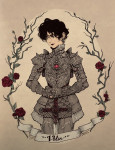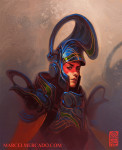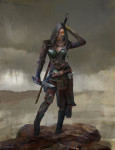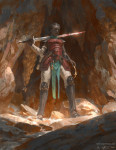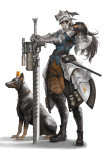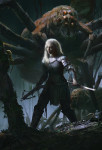Rick Wayne's Blog, page 25
March 14, 2020
(Fiction) Report All Cases
Next to the door was a decade-old public service poster urging everyone to get their annual vaccine. It dated from the early days of the contagion crisis and was full of implicit threats. Unlike the comparable posters from WWII, which reminded everyone that loose lips sank ships, this announcement warned that:
SILENCE SPREADS DISEASE!
REPORT ALL CASES TO YOUR
MINNESOTA CMC OFFICE
But the zombie apocalypse had never come. Out of a global population of nearly nine billion at the time, it was estimated that no more than twenty thousand had died from the “zombie” virus. And yet, it was a real catastrophe. Five times as many were victims of panic: riots, looting, and mob lynchings of those suspected of being infected—or even of hiding those that were. In a handful of now-famous court cases in Spain and the US, individuals filmed leading such mobs or breaking into homes were either acquitted or left with light sentences, particularly if they were women, on grounds that they were acting “in defense” of their families.
The ranciform encephalopathy virus didn’t give its victims a taste for brains, but it did attack the brain, causing swelling and depositing Alzheimer’s-like plaques that swiftly inhibited cognition. Over the course of a week, sometimes longer, the infected began to act increasingly irrational before eventually succumbing to an irresistible urge to wander away, presumably so the virus could infect others. Once consumed with wanderlust, their eyes frosted over, limiting their vision, and they quickly became oblivious to their surroundings, including heat, cold, and pain. Cause of death in many cases was not the virus itself but violent trauma. Many were struck by high-speed vehicles while wandering across a highway or intersection. Others fell into machinery or drowned.
The episode gripped the world. Although the pandemic was over in months, the economy fell into steep recession. Nio had been a teenager at the time, and she had lined up with everyone else to get the vaccine. There were still hundreds of cases per year—an endemic disease, like measles or chicken pox—but the common wisdom was that the remaining afflicted were anti-vaxxer holdouts or crazies who ranted online about it all being a massive conspiracy to inject everyone with mind control serum. What few “zombies” appeared, more than a decade after the initial crisis, were greeted with annoyance rather than fear, especially by the thousands of stranded commuters who waited helplessly in traffic for a city sanitation crew to come clean up the shattered body still dragging itself, legless, down the highway.
snippet from the new book-in-progress
March 13, 2020
(Curiosity) Where Have the Villainesses Gone?
[image error]
“Isn’t it time to acknowledge the ugly side? I’ve grown quite weary of the spunky heroines, brave rape victims, soul-searching fashionistas that stock so many books. I particularly mourn the lack of female villains — good, potent female villains. Not ill-tempered women who scheme about landing good men and better shoes (as if we had nothing more interesting to war over), not chilly WASP mothers (emotionally distant isn’t necessarily evil), not soapy vixens (merely bitchy doesn’t qualify either). I’m talking violent, wicked women. Scary women. Don’t tell me you don’t know some. The point is, women have spent so many years girl-powering ourselves — to the point of almost parodic encouragement — we’ve left no room to acknowledge our dark side. Dark sides are important. They should be nurtured like nasty black orchids.”
-Gillian Flynn, author of Gone Girl
I have to be honest. As much as I wanted to enjoy it, I found the plot of Gone Girl to be surprisingly ludicrous — a parade of pointless twists and hand-waving that defied basic sense — but the premise and the characters (Amy more than Nick) were compelling, and I give Ms. Flynn mad props for taking on a challenge.
But I really dig this quote. She is spot-on.
I love thrilling stories (more than literature or arthouse films) and I love women in action stories as something other than a damsel. It’s fun when the 110-lb. girl roundhouses the 250-lb., muscle-bound bad guy into the wall. It’s not at all believable, but it’s waaaaay better than her screaming in the corner with her polished nails pressed to her lips, waiting for her hero to save her.
While we certainly need more female leads, that spunky, Kewpie doll-heroine is only going to take us so far. On some level, we’re all still subtly aware that she’s in a Title IX role (Gillian’s “parodic girl-powering”). She’s a woman doing man-things, just with a low-cut top and model-perfect hair.
To see why it matters, we have to understand a very important fact about fiction: heroes must follow the rules. Only villains are free to make their own.
To be clear, “the rules” don’t have to be the law, or anything like it. They could simply be the hero’s own moral code, her sense of what’s right. Nor does the villain need to be missing such things. In fact, some of the best villains are overzealous legalists. But when pressed to the limit, the hero does what’s right. He may waver, but in the end, he lives how we wish we had the courage to, which may be as simple as sticking with his life’s dream of owning a farm after some financial trouble and a year of bad weather.
The villain, on the other hand, is anyone who gives up or sacrifices what’s right to achieve an aim, even where that aim might once have been good, such as returning order to a galaxy in chaos. Our villains, then, more so than our heroes, reflect — in the literal sense of that word: reveal in reverse — our moral autonomy.
We’ll know sexism is gasping when people don’t think twice about female villains, when it doesn’t bother them like it does now. And I’m not talking about the manipulative bitch or jilted vixen, which are mere perversions of the two traditional feminine roles: mother and sex object. I mean straight up inventive, devious, cunning, ruthless, potent villains. Not Harley Quinn but the Joker. Not Clarice Starling but Hannibal Lecter. Not Princess Leia but Darth Vader. Can you image Alex DeLarge, the protagonist from Anthony Burgess’s A Clockwork Orange, as a woman? How much would that change our feelings about the rape scene? Or her anti-violence “treatment”?
That doesn’t mean we can’t enjoy a good sultry villainess, like Catwoman. Personally, I have a very sick fascination with The Baroness from the G.I. Joe franchise. (Google her.) On their own, I don’t think there’s anything wrong with those characters, just as there’s nothing wrong with Thor as a variant of the stock, hypermasculine hero whose battles always seem to end with him partially shirtless and flexing his muscles.
Most people, it seems, still imagine gender as strictly binary, like two stars orbiting each other. In such a system, even where it’s constantly changing, women are only free to occupy new roles when men get out of the way. Femininity is freed only when we change our attitudes about masculinity, and vice versa.
What if 50 Shades of Gray were about an older, wealthy woman who sexually manipulates and sadomasochistically abuses a younger, naive man who becomes hopelessly enthralled with her? It seems more sinister somehow, straight-up psychological thriller versus soccer-mom erotica fantasy.
I would argue that’s not because women can’t be dominatrixes, clearly, but because men are not free to be weak and submissive, which comes across less as sympathetic than simply pathetic. If a woman makes them so, it is a genuine normative transgression (versus simply a slightly deviant hobby).
A male protagonist can be flawed: pathologically shy, for example. Damaged characters are interesting in any role. But if he’s passive, if he’s the object, we have no sympathy. We’ll think he had it coming and side with the abuser. A man’s story still has to be about him coming into his own power and autonomy to be anything other than a tragedy.
For women to be free to be the villain, then, we don’t need new attitudes about them, or not only. We need new attitudes about men.
There are a handful of great female villains already out there, of course. It’s been easy for later writers to re-imagine the Wicked Witch and Maleficent as heroes because the original villains were so robust. Similarly, Nurse Ratched (from One Flew Over the Cuckoo’s Nest) and Annie Wilkes (Kathy Bates’s character in Misery) are both legitimately terrifying.
But however well-executed, these are still mere perversions of traditional feminine roles: the witches are jilted vixens, the dark antithesis of the hero’s princess/sex object (rejected, rightly or wrongly, for another), and the nurses are the antithesis of the caretaker/mother, same as Other Mother from Gaiman’s Coraline.
I’m with Gillian. Where are the rest?
cover image “Young Evil-Lyn” by Allen Song
(Curiosity) Where Have All The Villainesses Gone?
[image error]
“Isn’t it time to acknowledge the ugly side? I’ve grown quite weary of the spunky heroines, brave rape victims, soul-searching fashionistas that stock so many books. I particularly mourn the lack of female villains — good, potent female villains. Not ill-tempered women who scheme about landing good men and better shoes (as if we had nothing more interesting to war over), not chilly WASP mothers (emotionally distant isn’t necessarily evil), not soapy vixens (merely bitchy doesn’t qualify either). I’m talking violent, wicked women. Scary women. Don’t tell me you don’t know some. The point is, women have spent so many years girl-powering ourselves — to the point of almost parodic encouragement — we’ve left no room to acknowledge our dark side. Dark sides are important. They should be nurtured like nasty black orchids.”
-Gillian Flynn, author of Gone Girl
I have to be honest. As much as I wanted to enjoy it, I found the plot of Gone Girl to be surprisingly ludicrous — a parade of pointless twists and hand-waving that defied basic sense — but the premise and the characters (Amy more than Nick) were compelling, and I give Ms. Flynn mad props for taking on a challenge.
But I really dig this quote. She is spot-on.
I love thrilling stories (more than literature or arthouse films) and I love women in action stories as something other than a damsel. It’s fun when the 110-lb. girl roundhouses the 250-lb., muscle-bound bad guy into the wall. It’s not at all believable, but it’s waaaaay better than her screaming in the corner with her polished nails pressed to her lips, waiting for her hero to save her.
While we certainly need more female leads, that spunky, Kewpie doll-heroine is only going to take us so far. On some level, we’re all still subtly aware that she’s in a Title IX role (Gillian’s “parodic girl-powering”). She’s a woman doing man-things, just with a low-cut top and model-perfect hair.
To see why it matters, we have to understand a very important fact about fiction: heroes must follow the rules. Only villains are free to make their own.
To be clear, “the rules” don’t have to be the law, or anything like it. They could simply be the hero’s own moral code, her sense of what’s right. Nor does the villain need to be missing such things. In fact, some of the best villains are overzealous legalists. But when pressed to the limit, the hero does what’s right. He may waver, but in the end, he lives how we wish we had the courage to, which may be as simple as sticking with his life’s dream of owning a farm after some financial trouble and a year of bad weather.
The villain, on the other hand, is anyone who gives up or sacrifices what’s right to achieve an aim, even where that aim might once have been good, such as returning order to a galaxy in chaos. Our villains, then, more so than our heroes, reflect — in the literal sense of that word: reveal in reverse — our moral autonomy.
We’ll know sexism is gasping when people don’t think twice about female villains, when it doesn’t bother them like it does now. And I’m not talking about the manipulative bitch or jilted vixen, which are mere perversions of the two traditional feminine roles: mother and sex object. I mean straight up inventive, devious, cunning, ruthless, potent villains. Not Harley Quinn but the Joker. Not Clarice Starling but Hannibal Lecter. Not Princess Leia but Darth Vader. Can you image Alex DeLarge, the protagonist from Anthony Burgess’s A Clockwork Orange, as a woman? How much would that change our feelings about the rape scene? Or her anti-violence “treatment”?
That doesn’t mean we can’t enjoy a good sultry villainess, like Catwoman. Personally, I have a very sick fascination with The Baroness from the G.I. Joe franchise. (Google her.) On their own, I don’t think there’s anything wrong with those characters, just as there’s nothing wrong with Thor as a variant of the stock, hypermasculine hero whose battles always seem to end with him partially shirtless and flexing his muscles.
Most people, it seems, still imagine gender as strictly binary, like two stars orbiting each other. In such a system, even where it’s constantly changing, women are only free to occupy new roles when men get out of the way. Femininity is freed only when we change our attitudes about masculinity, and vice versa.
What if 50 Shades of Gray were about an older, wealthy woman who sexually manipulates and sadomasochistically abuses a younger, naive man who becomes hopelessly enthralled with her? It seems more sinister somehow, straight-up psychological thriller versus soccer-mom erotica fantasy.
I would argue that’s not because women can’t be dominatrixes, clearly, but because men are not free to be weak and submissive, which comes across less as sympathetic than simply pathetic. If a woman makes them so, it is a genuine normative transgression (versus simply a slightly deviant hobby).
A male protagonist can be flawed: pathologically shy, for example. Damaged characters are interesting in any role. But if he’s passive, if he’s the object, we have no sympathy. We’ll think he had it coming and side with the abuser. A man’s story still has to be about him coming into his own power and autonomy to be anything other than a tragedy.
For women to be free to be the villain, then, we don’t need new attitudes about them, or not only. We need new attitudes about men.
There are a handful of great female villains already out there, of course. It’s been easy for later writers to re-imagine the Wicked Witch and Maleficent as heroes because the original villains were so robust. Similarly, Nurse Ratched (from One Flew Over the Cuckoo’s Nest) and Annie Wilkes (Kathy Bates’s character in Misery) are both legitimately terrifying.
But however well-executed, these are still mere perversions of traditional feminine roles: the witches are jilted vixens, the dark antithesis of the hero’s princess/sex object (rejected, rightly or wrongly, for another), and the nurses are the antithesis of the caretaker/mother, same as Other Mother from Gaiman’s Coraline.
I’m with Gillian. Where are the rest?
cover image “Young Evil-Lyn” by Allen Song
March 12, 2020
(Art) The Brilliant Colors of Kuri Huang
[image error]
Chinese artist Kuri Huang makes breathtakingly colorful illustrations of mythical figures and fairy tales. Despite the panoply of color, which seems explosive and yet soft at the same time, her palettes are wonderfully sublime.
Find more by the artist on her website.













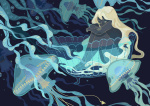



March 11, 2020
Symbols
[image error]The Holy Table of John Dee
[image error]Flag of the Posadist 4th International
[image error]From A.T. Mann’s 12 Mandalas
[image error]Comic art collage by Samplerman
[image error]
March 9, 2020
(Art) The Post-Apocalyptic Animorphs of Su Jian
[image error]
Chinese artist Su Jian imagines grim futures where anthropomorphic animals wander post-collapse Asia and techno-warriors battle robots and demons. Find more the artist on his ArtStation page.
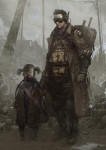

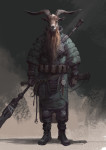

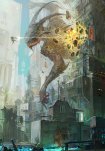







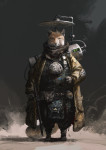

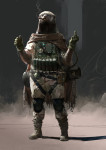


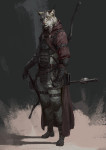




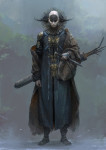


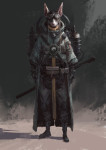
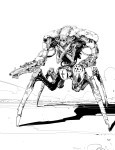


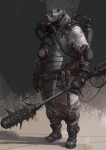
March 8, 2020
One Long Masturbation: Reply to the Belief that Things Were Better When
In 1818 the population of England was near twenty million, 80 percent of whom were functionally illiterate. The literate field, then, was approximately four hundred thousand. This was not only the maximum poetry audience, it was the field from which the country’s poets could come.
How many were there? Coleridge-Wordsworth-Blake-Byron-Shelley-Keats . . . ? Certainly. But we can pull out over another dozen without even opening our Palgrave: Crabbe, Hunt, Reynolds, Campbell, Scott, Moore, Southey, E. H. Coleridge, Landor, Darley, Hood, Praed, Clare, and Beddoes were all writing that same year. And at this point we’ve pretty much scraped the bottom of the barrel for acceptable thesis topics in British poetry for that decade. Twenty all together!
Out of a field of four hundred thousand, that’s six poets of major interest and fourteen of varying minor interest.
In the United States today [1972] we have nearly 225 million people. Perhaps 80 percent are literate, which gives us a literate field of 180 million from which we can cull both our audience and our poets—a field fifty times as large.
It is not unreasonable to suppose that, where there were six major and fourteen minor poets in England in 1818, today there are fifty times six major poets (about three hundred) and fifty times fourteen (about seven hundred) of merit and interest in America today.
In general, the standards of poetry are far higher than in Shelley’s time. Few little magazines today will accept verse with as much padding as the lines that filled The Edinburgh Review.
Still, most people would rather not respond to a poem at all without the reassurance of critical approbation/mystification . . . that element so necessary if a writer is to be, to whatever degree, “famous.” Fame has been used, by the academic, as a sort of mineral oil to make works of culture slip down the throats of students a bit more easily. But fame is a matter of individual attention/fascination. And, at present, there just isn’t enough of it to go around—not if you want to dole it out to poets according to merit.
I think people have known this in a vaguely inarticulate way for years: it has resulted in an immense effort to propagate the lie that while the population rises geometrically, the amount of poetic excellence remains an arithmetic constant.
Yes, 99 percent of what is written is awful. And perhaps 75 percent of what is published—a microscopically small fraction of what is written—is trivial. But what is good and published would fill barns.
And I suspect one can find analogs of this situation with the novel, the theater, dance . . .
— from Samuel R. Delany’s “Letter to a Critic: Popular Culture, High Art, and the SF Landscape” (1972) available in The Jewel-Hinged Jaw: Notes on the Language of Science Fiction.
In 2020, the population of the US is closer to 327 million, with another 66 million in the UK, 37 million in Canada, and 30 in Australia & New Zealand, meaning the population of the core English-speaking world nears half a billion souls, most of whom are better-educated, better-fed, and live longer than the English aristocracy of the Regency era.
If the laws of statistics hold — and why wouldn’t they? — we ought to have a 100 Keats in every generation. And if Delany is right, we probably do — if the threshold of merit has not changed; that is, if we judge today’s writers by the same standards of excellence.
There’s this idea that “Things were better when…” — that there has been a falling off in the arts (modern art specifically) — that despite the orders of magnitude more of it being produced than ever before, it has degraded from some imagined high.
I don’t know much about poetry. That was Delany’s analogy. But I do know a little about art history, although I am entirely self-taught. I’ve never taken a class, but I’ve read. Mostly, I went to museums. It was a perk of living in DC; they’re all free.
That’s important because it means I didn’t come to it wearing goggles I received from the establishment. Nor was I drawn in by the Impressionists, as most people seem to be. I actually came in at the beginning, which almost no one does. I came in via anthropology. I’ve shared an example before: the “Thinker” of Cernavoda. It mesmerized me.
We speak of things as timeless. Turn on the TV and within a few minutes, a baritone voice will extol the timelessness of the jewelry he wants you to buy for your wife. But the Thinker is timeless — in ways even the pyramids are not. They are remote. Impressive, but imposing. That was their purpose: to remind us that their inhabitants were explicitly NOT human. They were divine.
And yet, they’re crumbling.
Looking at the Thinker on his little stool, you can immediately identify with this fellow over a gap of five thousand years, which is bafflingly extraordinary. If that doesn’t give you goosebumps, you’re not seeing.
Because John Berger is right, there is a way to see — or rather ways of seeing, to use the name of his famous book. There is a visual vocabulary that you and I pick up in grade school and that includes a disposition to judge images of a certain sort “higher” than others.
The reason most non-Western art seems so pointlessly obtuse to Westerners is not because it’s infantile but because we lack the vocabulary to parse it. (I’ve written about that as well in The Sorrow of Radha.) We can’t tell a “high” image from a “low” one: it’s all foreign. But then, assuming you are a Westerner like me, it wasn’t made for us.
It’s not the least surprising to me that the great mass of people became turned off by art the moment it stopped being about them. Modern art isn’t about us. Modern art is about art. It’s art asking itself what art is, or can be.
Modern art is to art history what the “linguistic turn” in philosophy is to the history of ideas: an exhaustion. It is a looking around and wondering where else there is to go.
But there are more kinds of art made today than just the abstract, or whatever the critics tout. I share some on this blog. Alexander Korzer-Robinson excavates old books, an antiquarian archeology. Cyndy Salisbury makes carnival and opera masks, in both new and old styles. There are artists who make incredibly detailed maps of places that don’t exist, artists who paint in light and sculpt in shadow (see Fukuda).
What makes it into the news is the disgusting: Andres Serrano’s “Piss Christ” or Wim Delvoye’s “Cloaca,” a poop-making robot. It’s deliberately curated to be controversial, and while I freely admit I get a tickle out of that kind of thing, I don’t expect everyone will. In fact, I suspect it would tickle less if everyone did.
We think we “get” modern art because we’re raised on modern images. (Before modern reproduction technology, that wasn’t the case.) Children’s books and television are designed to be got. A child that can’t read can nevertheless follow the misadventures of Curious George in pictures while they are read to her by the babysitter.
A child can’t “get” a medieval triptych. She has to be baptized into it. But once she has the tools (a basic religious education), she gets it quite easily — again, even if she can’t read. This of course was the purpose of stained glass: to illustrate the path to salvation, like an airline safety pamphlet. And because images were so rare, stained glass would’ve seemed quite glorious, divine even, especially when lit by the sun.
It’s not clear to what degree an educated person of the Regency era would’ve “got” post-impressionism (or even impressionism). Some would’ve, surely. The rest, while recognizing that, for example, it was a picture of a starry night, might call it rubbish. “My God, man! It’s all blurry. I can’t see a damned thing!”
[image error]
Already with Van Gogh (active 1881-1890), there is a high level of abstraction. Those of us born after the impressionist period, whether we’re aware of it or not, learned the visual vocabulary, developed by impressionism necessary to see Van Gogh’s “Starry, Starry Night,” or Edvard Munch’s “The Scream,” and so on until….
The Great War. Full stop. WWI was an unprecedented shock to Western culture, which in 1900 was sure that it had just about figured everything out. It was a bigger shock than WWII, despite that fewer people died, because by WWII, we knew such things could happen, which is why we started numbering them.
After the war, European artists, who had been looked to as leaders of the culture (if not the society) for two centuries — hence the obsession with art-as-status-symbol — asked themselves: if this is the result, what’s it all for?
The immediate result was Dada, the shell shock of art, but that was just a fuse. Everything exploded from there.
The first point to get is that after 1918, high art stopped celebrating Western culture. It stopped being about you. More than that, it became abstract enough that it surpassed the common understanding. The visual vocabulary turned so complex that it required some measure of specialized study to partake in the conversation.
This was not unique to art. It was characteristic of all areas of study and “high culture” at the time. Until and perhaps even through the Victorian age, you could still lay claim to being a “Man of Letters,” which is to say you could have a passing knowledge of anything known with reasonable certainty, and even quite a bit that wasn’t.
By the 20th century, that was no longer the case. And yet, we don’t blame physicists that physics stopped being fully teachable at the high school level — that you have to be inducted in from there. We don’t expect physics to be about us. We expect it to explore something grander.
But people assume art is supposed to be for them. Try to stage anything other than a classical ballet at the community theater and woe to you! (We begrudgingly accept opera, despite that no one “gets it,” because it wears a patina of tradition.)
Delaney is right. 99% of art made today is crap. Like him, I mean ALL art, including by the hobbyist. 75% of art curated in commercial galleries (or even online) is at best trivial. That means it’s extraordinarily easy to pick out a few shoddy pieces and think that’s the whole of it. Picking at random, which is all the outsider can hope to do, that’s the likely result.
And yet, judging on the same standards of excellence as in the past, there is more great art being made today than ever before.
So why don’t we see it?
A lot of it, we simply don’t get. Not because we’re stupid. In as much as we have to be inducted, we lack the vocabulary, just as we lack the ability to interpret these colorized particle tracks, captured in a bubble chamber at CERN, which could easily be mistaken for modern art (there’s a reason for that as well).
[image error]
That is the first point. The second point is a little easier to grasp. There is a law in marketing, born through repeated experiment, that says it is better to be first than to be better. That is, the product that is first to market tends to do better over later entries, even those of a higher quality.
No one is defending this, by the way. It’s just a description of our purchasing behavior, of our psychology.
There is a corollary that says: once there was the Beatles, no one could be the Beatles again. The position is taken.
Given the numbers, it is probable that since the Beatles, there have existed other musicians who could’ve done Beatles-style music better than the Beatles, but since the Beatles were extraordinary enough — and came first — the matter is settled. Anyone else making Beatles music (like Klaatu) is relegated to the dustbin.
I’m convinced the contemporary Australian classic rock group Wolfmother, had they existed before Led Zeppelin, would’ve become a household name. But since Led Zeppelin beat them to existence by half a century, it’s the other way round. Wolfmother can’t help but sound derivative.
People are still painting impressionist paintings. But what can they do when it’s all been done? No matter how good they are, it’s still just repetition of a century-old form. Once you have the Beatles, you can never have the Beatles again. It sounds like a knockoff.
What the culture experiences writ large in this way we also experience personally over the course of our lives. I recently shared a quote from C.S. Lewis to that effect: “It is very rarely that in middle-age we find an author who gives us what we knew so often in our teens and twenties, the sense of having opened a new door.” Because once it’s been done and experienced, we no longer experience it as a novelty, as a peak.
When you say “Things were better when,” you are expressing a taste. You may as well have told me you prefer chocolate ice cream.
But when people say “Art was better when,” they tend to mean more than that. They mean it has fallen, something closer to “The chocolate ice cream of today is not as good as the chocolate ice cream of my youth.”
It’s possible. Statistically, it’s very unlikely. Given there are more kinds of chocolate ice cream, and more kinds of cacao, being produced than ever before — more than one could practically sample, I expect — one would expect a significant portion of it to be crap, and that’s fair.
But whatever the difference in proportion, in absolute terms, there are more excellent chocolate ice creams — or wines of the vintage, or love songs, or visual art — being produced now than at any time in history.
The problem for the casual observer is that this is not instantly apparent. And in fact, I think what these folks are really lamenting is not the state of art at all but the state of society, which has turned into an escaping nuclear reaction. (Their complaints are not unique to art.) The world itself is not as immediately comprehensible as it was in the past — or as we imagine the past.
That’s not to say anyone has to like modern art, or the inflated commercial enterprise of the same name. But art as it’s being produced today (or novels, or the theater) has not fallen off the pedestal. It’s just not what some people want it to be.
[image error]
March 6, 2020
Fear is the mind killer
[image error]
By science writer Maggie Koerth
March 5, 2020
(Fiction) Cleaning Agent Blues
Nio adjusted the heavy bag on her shoulder as she paced around the bus stop, stepping carefully over an icy sidewalk pockmarked in frozen footprints, like the fossil of a prehistoric riverbed. It was the fourth day of record-setting April cold. It was supposed to last another four. She fastened the top two snaps on her puffy winter coat and huddled into it like a turtle. Her breath billowed over the collar, now nose-high, and caught the yellow light from the all-night diner around the corner. A quick check of her phone confirmed there was limited secure coverage in the town. Two bars. That meant she couldn’t risk stepping inside. She’d have to wait—or let the trail go as cold as her fingers. She looked up and down the deserted street again. The remnants of the unexpected blizzard had been churned by the day’s traffic into crisscrossing tracks of slush. Nothing traveled. Across from her, a block monster of a pay phone with an armored cord sat under its glass-and-steel hood, top-lit by a fluorescent lamp, like a comic book villain.
As she turned away, the light blinked twice.
Nio stopped. A moment later, it did it again.
Blink blink.
She switched her bulky delivery bag to her right shoulder and crossed the street. Her boots plowed through the slush, breaking the angled rows into Morse-like dots and dashes. She lifted the phone’s handset to her ear. At first, there was nothing. Then she heard scratching, like the rustle of fabric over a microphone.
“Your wifi is on,” the man on the other end told her. He spoke in a low voice as if he was trying not to be heard. “I can see the signal.”
“I’m running Parfait,” she explained. “I barely have a signal out here.”
“Turn it off.”
Nio sighed. Holding the handset to her ear with her shoulder, she dropped her soft-sided delivery bag to the icy sidewalk and dug out her phone. The exterior of her jacket was a dark blue-gray, but the interior was bright hunter’s orange, and it seemed to glow under the pay phone’s villainously strong fluorescent light.
“Don’t just put it on travel mode,” the man chided. He sounded young, early 20s maybe.
Nio held the button on her phone with a frigid finger until the animation appeared on the screen. She watched it power down amid the bright fog of her breath.
“There. It’s off.”
There was a pause. “I’m picking up an RFID.”
“Seriously? It’s freezing out here.”
“Dump it.”
“I can’t. It’s my boots.”
She heard whispering.
“We said nothing wired,” he told her.
“Yeah, I know. It was a mistake. This is my favorite pair, and they only make them smart. I’ve never connected them to anything.”
Another rustling pause. Nio thought she might’ve heard muffled voices.
“Take them off,” the man said.
“Excuse me?”
“Your boots. Take them off and throw them up the bank.”
Nio looked down at the waves of smooth white ice on the sidewalk. “You’re kidding.”
“Take off your boots and throw them up the bank,” the man repeated. Someone objected in the background, a young woman, but the man on the phone hushed her.
Nio stayed silent in frustration. But the client waited, undeterred. She looked up. The black cord that rose from the phone joined the cluster of wires atop a nearby pole but broke away immediately and angled off on its own into the neighborhood. Closed circuit. The man on the other end covered the receiver to mute it. But he did it imperfectly, and Nio heard faint voices. Arguing. She could only catch a few words, but it was clear the subject was her—specifically, her boots.
“Fine,” she said. “Whatever.”
She kicked off her half-laced hiking boots one at a time. They turned end over end in the air and landed with a crunch in the snow of the adjacent bank. Her bright multicolored striped socks were thin, and her toes curled involuntarily over ice. The cold shot immediately up her legs to her spine, and she shivered.
“We good?” she asked.
“Up the hill,” the man said. “First street on your left. Third house on your right, the one with the wreath on the door. Don’t ring the doorbell. Understand? Don’t even touch it. Just come in.”
Click.
Nio replaced the receiver in its cradle and followed the instructions. Without her boots, she had to shuffle in short steps to keep from slipping, which she nearly did twice.
“This is ridiculous.”
An early 2000s Ford pickup passed on the road, its bed fishtailing in the slush, but if the driver noticed her shoeless feet, he didn’t care.
The third house on the right was a rectangular single-family home just as unremarkable as the rest, sheathed in off-white vinyl siding and topped in dark composite shingles. There was a separate garage at the back reachable by a narrow drive. A Christmas wreath hung from the plywood door, inside a mesh screen door with no latch. Nio opened both and stepped inside. It was at most 10 degrees warmer. She could still see her breath pour over her high collar. But at least her toes were off the ice. They tread uncomfortably flat carpet instead. It smelled like a storage room. Christmas lights celebrated silently on faux-wood paneling. The only furniture was a corduroy-upholstered love seat. Down the hall, the doors to the bedrooms were open. The first looked like a cross between a doctor’s office and a tattoo shop—a mod parlor. Wheeled medical equipment on tall stands stood like soldiers around an examination table. Art and client photos were pinned to the wall in a cluster at the back. South Dakota was one of nine states where modding was illegal, although it was not illegal to have one, as long as it was acquired elsewhere.
She heard the squeak of a back door and the steady thump of calm footsteps on vinyl. A tall, mixed-race man with a long face appeared in the doorway to the empty kitchen. He studied her. He was maybe 19 or 20. His hair was neatly cropped, as was the pencil mustache on his upper lip. He was giving her the gruff treatment—head cocked back, hands in his pockets—but she suspected he could be quite affable when he wanted. He had kind eyes. He was dressed in work boots and a well-used mechanic’s bodysuit, open at the front to reveal a white Tabasco Sauce T-shirt. His oval name patch said Dell in script stitching.
“You the cleaning agent?” he asked. It was the same voice from the telephone.
Nio nodded. Her cold, wet toes curled in her socks. “This bag is a little heavy,” she said, adjusting it again.
“Open it up.”
“Really?”
He waved at her to get on with it, and she lowered it to the floor and unzipped it the flap. At the top was a layer of black restaurant takeout boxes. She lifted one to show the neatly organized menagerie underneath.
“Happy?”
“Clever,” he said, nodding to the side.
It was a soft-sided food delivery bag, foil-lined and insulated. The white logo of a popular online meal delivery service was emblazoned on red. It was gaudy and impossible to miss, but given that such bags were everywhere, it was also impossible to notice.
“They use the same kind of material to transport organs,” Nio explained, zipping it again.
“Now you.”
Nio sighed. She stood and unsnapped her knee-length coat in one pull. She held out her arms while the young man felt over her pockets. He pulled out her phone and made sure it was off. He pulled out an official-looking letter, unopened.
“That’s private,” she said.
He gave it back and felt inside her coat.
“What the fuck is this?”
He removed a large tarot deck. The box was worn at the corners. Nio didn’t answer the question, but she must have passed muster because he gave it back and reached for his pocket, as if going for a wallet.
“Do we do this now or . . .”
“Preferably.”
Dell produced his phone and typed a brief message to someone. A moment later, the back door creaked a second time and a young woman appeared. Her skin was a striking shade of pale blue, with just enough lavender to keep it from looking like a joke. She also had short, blunted devil horns implanted under the skin of her forehead and whole-eye fuchsia lenses. Her lips and fingernails were painted to match, and her long, wispy hair was dyed in a matching amethyst.
“Nice work,” Nio said.
“I’m Dell,” the young man told her. “This is Ticity.”
It was cosplay. The young woman was meant to resemble Gogo Ichigo, a cutesy blue-skinned anime succubus who bounced around in revealing clothes, seemingly oblivious to the effect it had on the slightly perverted Japanese high school boy who found her. Every episode involved him inventing some hair-brained scheme to impress her on the hopes that she would fall in love with him. When his plans inevitably failed, he wound up in trouble, and she would have to rescue him, either with her magical bouncing breasts, which hypnotized bad guys, or with her leaping vaginal flame attack, which burnt them to a crisp. Ticity’s mod was exceptional, and she was clearly proud of it. She was showing it off, even in the cold, with tight cutoff jeans, heeled knee-high boots, and a tank top, not much larger than a bikini, that bulged around her blue cleavage. Her arms were stuffed into a winter coat but she kept it off her shoulders, like she was perpetually about to disrobe.
She reached into her fur-lined coat and produced a fat folded stack of bills.
“Cash?” Nio asked, incredulous.
“Tips,” the young woman explained, holding it out.
By “tips,” Nio understood the young woman to mean from stripping. Hard to use credit, or crypto, in that business. Nio noticed Ticity’s fingers as she took the stack. Fingers were hard, and hers were flawless.
“Must have cost a fortune.”
“My boyfriend’s a mod artist, so . . .”
Turning human skin a primary color was easy. You simply injected the dermis with a CRISPR solution that caused the dermal cells to express an otherwise harmless enzyme that acted on any of a number of naturally occurring carbon-ring molecules—reducing them or adding a methyl group as necessary. But primary colors were loud and unsightly and people only used them to roleplay Star Trek aliens. Subtle secondary colors, like Ticity’s, required mixing. Vividness and opacity were achieved by including operons—genes that control the expression of other genes—in the modified DNA to regulate the amount of each coloration enzyme. In Ticity’s case, it meant light methylation (blue) with the barest hint of hemoglobin reduction (pink). It was a real art and easy to get wrong, and the internet was full disaster pictures: home modders with more ambition than sense who downloaded specs for someone else’s blend and turned themselves an awful shade of puke green.
Fortunately, the effect was temporary; in the case of an RNA vector, mere hours—just long enough for a concert. Even an injection of DNA eventually faded. Since the dermis grows slowly outward, all modified cells were slowly sloughed. But that often took 18 months or more, akin to regrowing long hair after a chop—a long time to look like walking vomit.
Ticity pointed with a polished red nail toward the back. “Becks is this way.”
Nio followed but stopped at the back door. More snow.
“Fuck.”
It sank under her socks with a crunch as she tiptoed after her guides, who took her through the side door of the backyard garage. The interior was packed with junk. The concrete floor was stained with oil. Dead leaves and sawdust gathered in the corners. A heavy square of filthy carpet hung from the back wall like a tapestry. Dell lifted it, revealing an irregular hole, and the three of them stepped through a narrow gap and into another garage, just as old as the first but open and swept clean. It was attached to its house. Nio heard several distant moans as soon as Dell shut the door behind them.
It was hot inside—unusually hot—and Nio understood why both Dell and Ticity had their jackets open. Unlike the first house, the second was clearly lived-in. Appliances cluttered the counter. Dirty dishes cluttered the sink. Two men were playing video games in the living room. They stopped when Nio appeared. They were nervous. The ashtray on the coffee table overflowed with joint butts. An assemble-it-yourself kitchen stand leaned against a recliner. Over it, a vintage corded phone hung from the wall next to a scuffed bookshelf proudly displaying a small collection of pornographic bongs and a very large collection of retro gaming cartridges for consoles that were no longer made. Retro gaming was popular—especially games that were rare or hadn’t been re-encoded on newer media—which meant the collection was expensive and difficult to gather and so immediately impressive to any gamer, which was probably why it was the place of honor. It was the first thing anyone saw coming in the front door.
At the back of the room, three wall-mounted flat screens—one large and two small—were connected by snaking wires to consoles and controllers. A box in the corner suggested at least one of them was new. Plugged into the wall next to it was a small orange-and-white Canine Companion—a doggie love doll, a four-legged plastic device designed to appease dogs with a humping problem.
“This is Rand and Koil,” Dell said, pointing in turn to the young men.
They were both modded as well, but nothing like Ticity. Only Rand, who had a beard, looked old enough to drink. His winter cap was pulled tightly over his curly hair. Short, tusklike fangs erupted from his lower jaw, like an ogre.
“She’s downstairs,” Ticity said, walking to the hall.
“He locked the door,” Rand called to her from the floor of the living room. His voice was deepened and his vowels blunted by the heavy tusks.
Ticity walked back to where she could see him.
“He said he’d have news later today.” Rand turned to Dell. “That was all.”
Dell walked into the hall and tried the plywood door. Locked.
“What do we do?” Ticity whispered.
Nio walked to the couch, pulled the bag of weed from between the cushions, and removed the black office clip that held it shut. She pinched the arms of a chrome latch together and removed it from the holes of the clip. Then she inserted the small round end, like a paper clip, into a small hole under the door knob.
“These old doors had releases for firemen—and parents wanting to catch their kids in the act.”
There was a click, and the door to the basement swung free.
“No shit?” Dell said. “Dang, man. I’ve been wanting to do that for months.”
He went down first, and Nio followed. Slat steps descended to an open unfinished basement—a maker lab, and a reasonably-well stocked one at that. Someone in the house had money. A blinking slab of angled white plastic, a refraction panel, stood like a monolith in the middle of the room. It was plugged into a power strip whose cord disappeared under a dark pinball machine. The panel scattered EM signals, making it hard for anyone outside to eavesdrop. It was also a sensitive detector. That was why they had insisted on nothing wired. It would’ve set off the alarm.
Behind the stairs, rows of IV stands dangled plastic bags linked to each other by looped tubing. Most were out of use. There were three makers, including an old glass-walled 3D printer, about the size of a commercial oven, that had been stripped for parts. It sat on the rack in a corner looking like an empty arcade claw game. Three pieces of equipment they didn’t want anyone to see had been covered with bedsheets of different colors. One had flowers on it. Red lights blinked underneath.
In the opposite corner was a kind of makeshift quarantine. Sheets of opaque plastic hung from the exposed joists in the ceiling. Next to it was a workstation of mismatched desks over which several screens were mounted. A CRT monitor sat unused on the floor amid a tangle of cords. Sitting at the desk, seemingly hard at work on a custom protein, which turned in three dimensions on a large hi-def display, was a stylishly dressed young man in a headset. The music was loud, and he bobbed his head, oblivious. Dell stepped forward to get his attention. The others hung back. They looked scared.
The young man at the desk looked up with a start and pulled off his headphones. Music blared from the speakers. There were old books on the shelf behind him on the Macy Conferences, cybernetic theory, and MK-Ultra, along with several glossy publications by Disinformation.
“What the fuck?” he yelled. “What the fuck are you doing here?”
He looked Southeast Asian but styled himself like a K-pop star. He had perfectly clear skin, vaguely feminine cheekbones, and coiffed side-swirl hair that he tossed casually as he stood.
Dell played it cool. He pointed at the man with his forefinger but kept his thumb raised like a gun. “This is the king, my man Guillermo,” he said to Nio.
The kid seemed genuinely shocked. He looked to Ticity, who hid behind Nio on the stairs. “What the fuck?” he said again. “Who the fuck is this?”
“The cleaner, man. We told you.”
“You didn’t tell me shit.”
Guillermo stormed forward, passing briefly under a long blacklight which caused his entire skeleton fluoresce yellow-green. It was a mod, and a dangerous one, meant to garner a lot of looks at the dance club without getting him fired from the day job, if he had one. By his name, she guessed he was Filipino. Three-and-a-half centuries of Spanish rule had left an indelible mark. By his dress and manner, she guessed he was the source of the money—or maybe his parents. He wasn’t any older than the others.
“Don’t be mad,” Ticity said in a pouty voice.
Nio caught movement then behind the opaque plastic sheeting, and she stepped away as the others began to argue. She parted the plastic. Inside, a shirtless girl lay belly-down on a bare mattress, grimacing. Nio froze at the sight. It wasn’t just that the skin of the girl’s right shoulder was swollen in a wide translucent hump, like a foot-wide clear mucus blister, or that she was obviously in terrible pain. It was her age. Nio doubted she was old enough to drive.
She glanced back to Ticity. Under the mods, there was a clear resemblance. Younger sister maybe.
A tiny dog, a Pomeranian that had been keeping the girl company, scurried across the floor to Ticity, who picked it up and nuzzled it as Dell and Guillermo tried their best not to raise their voices at each other.
“You must be Becks,” Nio said. She stepped through the noisy plastic and knelt next to the mattress. “I’m Nio. Is it okay if I take a look?”
The girl nodded once. She studied Nio the same way Dell had. “What happened to your hair?” She sounded all of 14.
The need to draw a deep enough breath to make words caused her pain, and the girl shut her eyes. A lonely tear slid down her cheek.
“I was in a cult,” Nio said, scowling at the enormous lesion.
The girl smiled weakly, as if she wanted to laugh. She lay with her face sideways on the mattress and didn’t move. Near her head were crumpled tissues and several empty bottles of water.
Nio dropped her bag and removed her coat. Under she wore dark wide-legged work pants and a white over-sized sweatshirt with the wrists and collar cut off.
“Any fever?” She touched the girl’s forehead, but it was cool.
Too cool.
Becks was both shorter than her sister and fuller-figured. Her breasts bulged from her sides. The fact that she was shirtless in company suggested her skin was sensitive and anything that touched it hurt. In turn, the others hung plastic—packaging from the new TV, it seemed—and kept the house unusually warm.
Nio removed the top layer of takeout boxes from her bag and set them carefully to the side.
“What’s that?” Ticity asked nervously from several steps away. The argument, which was still raging in hushed voices, had clearly upset her.
Nio glanced back. It seemed the boys might come to blows.
“My lunch,” she joked.
The girl on the mattress smiled at it, and Nio smiled back.
“Becks,” Nio repeated the name. “Is that short for something?”
“Beckham,” she said.
“That’s pretty.”
The base of the insulated delivery bag was organized into square sections stuffed with various medical tools and implements.
“Here.” Nio held a stack of individually wrapped surgical masks into the air. “Put these on. All of you.”
“Why? What’s wrong?” Ticity asked.
Dell took them and handed them out while Nio peeled plastic from paper and slipped her mask around her ears. “Just a precaution,” she said through blue fabric.
“What’s wrong with me?” Beckham asked. “Is it bad?” She swallowed once, fighting the pain of speaking.
The right side of the girl’s back was swollen in an oblong dome at least three inches high at the center. The tissue was soft and translucent. There were swathes of shadow underneath but no discernible shape or pattern. The left side of her back was normal, but there was a black X over her scapula, handwritten in permanent marker and surrounded by a pentagram of hexadecimals.
“Everyone says it isn’t bad, but they won’t take a picture or let me see.” She was petrified.
Nio opted for honesty. “It looks like you guys might’ve downloaded a little something extra.”
“Like a virus?” Ticity’s eyes went wide. She turned to Guillermo, still clutching her dog. “You said it was just an infection!” She hit him.
“No way! No way, babe. I scanned it. Okay? Trust—”
Ticity hit him three times more. The dog barked.
“I scanned the whole thing! Stop it.”
“With what?” Nio asked, “if you don’t mind me asking.” She slipped a pair of latex gloves over her hands.
“Kitkat,” he said defiantly. “And Base10. And a bunch of other shit you probably haven’t heard of. I was careful. I told them she’d be fine. I know what I’m doing.”
He wasn’t telling Nio. He was telling the others. Dell stood behind him. The other two boys hung by the stairs, as if they preferred to be elsewhere but were trying to be supportive. Nio got the sense they were Dell’s crew, not Guillermo’s. The tall man had been smart and made sure he had backup in case of a confrontation.
“Kitkat and Base10 are good,” Nio said, touching gingerly around the translucent lesion.
Becks grimaced. The skin around the swelling was cool but firm and normal. Whatever it was, it appeared to be contained in a large watery cyst.
“See?” Guillermo raised his hands. “That’s what I said. This is pointless. This is a waste of money.”
Nio turned back to her bag. “But anti-virus apps only compare random snippets from a digital sequence with a library of known threats. And they reduce everything to an algorithmic fingerprint first, to shorten processing time. It’s a good screen, but it doesn’t protect against sophisticated malnomes. RNA isn’t like computer code. It can be read in both directions.”
“What does that mean?” Becks asked meekly.
“I fucking know that,” Guillermo said with menace. “Are you seriously telling me my business right now?” He stepped back in exaggerated shock. “You come to my house and disrespect me? Like I’m a fuckin’ idiot. I know what the fuck I’m doing, bitch.”
“Stop.” Ticity stepped in front of him. In her knee-high boots, she was a centimeter taller.
Guillermo ignored her. “I’m an artist. People know me. Who the fuck are you, huh? Someone who cleans up other people’s messes? You’re, like, a glorified maid.” He made shooing motions with his hands. “Clean up the mess, maid. Keep your opinions to yourself.”
“Stop it!” Ticity pushed him one-handed. “She’s trying to help.”
The dog barked again. It was shaking with excitement, and she set it down.
An awkward silence descended as Nio prepared several injections in her bag, out of sight of the girl, who was still waiting wide-eyed for an answer to her question.
“It means,” Nio said softly, “there are clever ways of hiding malicious code. You can include instructions that flipflop the direction of transcription, for example, and you can disguise functional groups with snip sequences—junk parts that are removed later.”
“Am I turning into a zombie?”
“Have you had this year’s vaccine?”
“Yes.”
“Then you should be fine.”
Nio ripped a sterile wipe from its packet and washed the girl’s skin just to the side of the translucent skin. The girl shut her eyes and whimpered softly with the motion. Nio kept talking to distract her.
“Apps like Kitkat and Base10 and Chive are good for the easy stuff, but if you’re gonna download bootleg mods, or even if you buy a seq from a legit source and string it yourself, you still need to render all of the proteins in a good digital modeler first. Not just the ones that get flagged by the software.”
“I fucking did that,” Guillermo objected. He turned to Ticity. “Babe, I did that. I swear. This bitch is just saying shit to make herself look good. I mean”—he laughed—“she’s gotta justify what we’re payin’ her, right? For fucking maid service.”
“You aren’t the one who payed me,” Nio said. She uncapped one of the needles she’d prepared.
“You fucking cunt.” Guillermo pushed past Ticity, but Dell stopped him with along arm.
“Calm down, man. Let her do her thing.”
The dog barked several times.
“This might hurt a little,” Nio told the girl.
“What is that?” Becks asked, eyeing the needle.
“Naw, man. Naw.” Guillermo was raging. “This is bullshit. Bull-shit! She gonna come in here and try to blame this shit on me. ME? This is fucking bullshit.”
The little dog was barking in front of him, and Guillermo nearly kicked it. “Get out of here!”
“It’s just saline,” Nio explained. “I wanna see if there’s a reaction before we do anything else.”
Becks nodded, and Nio poked her skin. The girl drew breath and bit her lip. But nothing happened.
Dell pulled Guillermo to the back.
“Bullshit, man. Bullshit!”
“Are you on any medication?” Nio asked.
Becks shook her head, grimacing.
“We gave her some oxy,” Ticity said. “For the pain.” She had retrieved the dog and was cuddling it.
“Oh, that’s right.” Becks’ face blushed against the mattress. “I forgot.”
“It’s not helping?” Nio asked.
“It was. At first.”
Nio put the needle back in the bag and prepared an anesthetic. “Any allergies?”
“No.”
Nio turned to Ticity, who confirmed that with a shake of her head.
“What about drugs? Be honest.”
“Dust,” she said. “Last weekend. And weed. Almost every day.”
Dell was arguing with Guillermo, who stood under the blacklight glowering at Nio between curses and objections. Most of his upper skeleton was visible, as if lit in relief, although the effect faded at his ribs. He was the only person in the room not wearing a surgical mask. Dell had given him one, but he had crumpled it defiantly in his hand.
The two other boys, who had been silent before, joined Dell in trying to defuse the situation, which only made things worse. Guillermo felt attacked by everyone and began to shout. He pushed one of them and kept repeating that it was his house.
“Alcohol?” Nio asked over the noise.
“Not since last night. No, wait. Two nights ago.”
“How long have you been down here?”
“Since yesterday morning,” Ticity answered nervously. She knelt and squeezed her sister’s fingers gently. “I told our mom she was staying with me.”
“Have you modded yourself in the past year?”
“This was going to be her first,” Ticity said with a tear. She took off her surgical mask and wiped her face with her long-nailed fingers. She used the mask like a tissue.
“First time, huh?” Nio injected the anesthetic carefully. “That’s exciting.”
Becks grunted in pain. “What’s that?”
“This is an anesthetic. You may feel a little sleepy in a moment, but I need you to try and stay awake, okay?”
The girl nodded.
“FUCK THIS!” Guillermo pushed the others away and stormed up the stairs. “Fuck you. Fuck all of you. I’m calling Raoul.”
“Shit.” Dell’s head dropped. He turned at Ticity. The look on her face suggested that was bad.
After giving the anesthetic a moment to take effect, Nio jabbed Beckham’s skin several times with a stiff finger. There was no response, and Nio reached for an aspiration needle.
Everyone heard Guillermo’s heavy footsteps on the floor above. He was pacing back and forth.
“Go see what he’s doing,” Dell told the kid named Koil, who climbed the stairs like a scolded child.
Nio lifted the unusually long needle and held it over the translucent swelling as if she were about to sacrifice it on an altar.
“Aw hell no.” The bearded Rand too one look and followed his friend up.
The needle went in deep—and something twitched.
Ticity yelped and jumped back. She covered her mouth with blood-red fingernails.
“What the . . .” Dell’s mouth hung open. At some point during his argument with Guillermo, he had removed his mask. He quickly put it back on.
The moving object was just as translucent as the surrounding tissue, and it was hard to discern a shape, but whatever it was, it wanted out. It was squirming.
“Beckham?” Nio asked loudly. “How you doing?”
“I’m so tired . . .” she breathed. “I can hear them . . .”
“What is that?” Ticity asked.
“Hear them?” Nio raised her voice as she dug in her bag. “Hear who?”
“The others . . . Like . . . singing . . .”
“Beckham?” Nio tore open a metal-tipped plastic scalpel and popped the cap on a small squirt bottle of iodine. “Beckham, stay with me. What were you gonna get? Wings?”
“Yeah . . .” The girl nodded weakly.
“Angel wings or devil wings?” She doused the girl’s back in brown liquid.
“Angel wings,” Ticity answered in place of her sister, who had passed out. “She knew they wouldn’t work. She just wanted to look like a Victoria’s Secret model for her sweet sixteen. They take like a year to grow. It was gonna be my present.”
The younger girl’s eyes were shut and fluttering as if she were having a seizure, but her muscles were still.
“What’s happening?” Ticity let the tiny dog go again and reached for her sister’s hand.
Nio heard the back door open and shut. Somebody was leaving. Guillermo stomped down the stairs a moment later. Dell got quiet—too quiet. Ticity gasped. Nio turned.
Guillermo had a gun.
“Raoul’s coming,” he announced. “And we’re gonna sort this out.”
Ticity stood. “What the fuck?” she yelled. “What the fuck is that for? What the fuck are you even doing right now?”
“He trippin.” Dell had his palms up. “Calm down, man.”
Guillermo pointed the gun at Nio from the base of the stairs. “Get away from her,” he ordered.
“Look at her!” Ticity was raging. “Look at my sister! Look at her back! It’s fucking moving! I said we should go to the hospit—”
“YOU’RE NOT LISTENING TO ME, TICITY!” Guillermo screamed. “Isn’t that what you tell me? YOU’RE NOT LISTENING!”
“And what the fuck is your psycho gangster friend gonna do? Raoul’s got fucking magic or something now?”
“He knows people. You know he knows people. You’re just trying to twist everything like you always do, like I don’t care about your sister or something. Raoul has people who can fix this and we should’ve called him instead of some strange bitch off the internet.”
“HOW? How can they fix it? By making my little sister disappear? He doesn’t care about you. Or me. Or anyone. He only cares about your little side business and he’s not going to do anything to risk getting caught. He only brought you in because your mom’s a doctor and you’re his hookup. Raoul’s a sick fuck and you’re a little bitch for sucking up to him!”
Guillermo forced the barrel of the gun into the young woman’s pale blue mouth and she stumbled back in her heeled boots and whimpered against one of the scatter panels as the little dog jumped and barked around her.
“What am I?” Guillermo yelled. “Say it, Ticity! What am I?”
“The word ‘cunt’ comes to mind,” Nio answered.
Everyone turned. Nio had a pair of needles in Beckham’s back and was trying to wrangle the squirming jellyfish inside the domelike cyst. The little Pomeranian barked and growled at Guillermo’s feet, and he kicked it like a soccer ball and stormed toward Nio. The dog squealed and bounced off the desk and landed on Beckham. The sudden pressure triggered the cyst and four translucent arms of mucus shot outward, sticking to whatever obstructed their path: the back of a computer screen, a vent under the narrow window, Dell’s chest. The fourth and final forced the little dog into the air and pinned it the ceiling, its tiny legs squirming.
“Whoa!”
Everybody froze.
Ticity screamed, first at the dog, then at the mucal tube attached to Dell’s chest. Dell screamed at his chest, then at the dog, then at his chest again as the squirming jellyfish in Beckham’s back undulated like a worm up the tube attached to the vent. Nio went to grab it, but Guillermo came for her with the gun. She spun on her knees and knocked it to the side with one hand while stabbing him in the chest with a needle. She pressed the plunger and he collapsed instantly to his knees. He shook his head. He tried to speak, but his words were slurred.
“Fuck.” Nio looked up as the undulating organism, like a jellyfish, disappeared through the grates of the vent. “Fuckfuckfuckfuck.”
She ran to Dell and pulled the stiff, slimy mucus off his chest. The giant cyst hadn’t erupted at random. It had sensed temperature variations, hoping one was an exit. Humans were warm, and Dell was the tallest there. The computer screen exhaled hot air from its vent. And of course the vent near the ceiling had been blasting the heat for the sick girl. It was the hottest.
Ticity had her hands on Guillermo, who swayed on his knees and mumbled in long, slow vowels.
“What did you do to him?”
“It’s just insulin,” Nio said, clearing the last of the stringy mucus from Dell’s chest with her gloved hands. “Not enough to put him in a coma. Just enough to suck the fight out of him.”
Even after everything, she was worried about him.
Nio looked to the handful of bubbling IV stands under the stairs, then to the equipment under the sheets.
“Fuck.” She turned to Dell. “Take off your clothes and get them out of here,” she ordered.
He nodded, wide-eyed.
“You have a burn protocol?” she asked.
He shook his head.
“Shit.” Nio trotted to the stairs, then ran back and snatched her coat. “Get her to a hospital or she’ll die.” She pointed at Becks. “Wrap her in the plastic. And hurry. I’m burning this place down.”
“WHAT?” Ticity screamed.
“Hurry!” Dell yelled at her.
Nio ran upstairs and grabbed the bottle of cooking oil she had noticed by the stove. She tossed some on the ceiling in the hall, at the very center of the house, and poured a trail down the wall and across the carpet to the kitchen, where she set the bottle on the floor. She yanked the Canine Companion from the living room wall and smashed it. Inside, the electrical cord was attached to a long, stiff heating prong. Dogs liked a warm companion, it seemed, just like people. She plugged the cord into a socket in the kitchen and inverted the prong into the half-empty bottle of oil. By then, Ticity appeared at the top of the steps, helping her dazed and confused asshole boyfriend, wet dog barking at his feet.
“Out the front!” Nio yelled.
Dell appeared a moment later carrying the unconscious Beckham, whom he’d wrapped in one of the tarps like a blanket. The front door opened and cold air burst into the room. Nio stormed to the bathroom and found Ticity’s hair spray. Then she snagged the lighter from the coffee table, next to the ashtray full of butts. She was about to walk out the door when Ticity reappeared, fuchsia-eyed and panicked.
“My Blahniks!” she yelled.
The heating prong lit the oil, and a gentle flame appeared and steadily followed the trail across the floor.
“Go!” Nio pushed her back onto the porch.
Dell stood in the snow in borrowed boots and boxer shorts, holding the unconscious Beckham like a fallen soldier. “Looks like it went into the field,” he said.
He was right. From a crack in the siding near the brick foundation, an odd trail in the snow stretched across the yard to the street, where the snow had been compacted by passing cars. Nio ran across it, nearly slipping.
“You ain’t got no shoes!” Dell called to her.
“Get her to a hospital!” she screamed.
Her socks crunched through the piled snow of the ditch on the far side and she sunk to her knees. But she found the trail. It passed through a row of leafless bushes to the open field beyond—a giant square bounded by straight lines of windbreaker trees on all four sides. In summer, the field would’ve been pitch black on a moonless night, but now it was covered in a foot of snow, which faintly reflected the light from the neighborhood, giving everything a twilight glow. It was empty except for three piles of railroad ties, stacked in alternating layers. The track in the snow arced right to them, and Nio followed.
The ties were old. They weren’t quite rotted through, but they were weathered and fraying. That gave the creature plenty of places to hide.
Nio knew the instructions necessary for an organism to move about its environment were not complicated. It’s a skill even the simplest organisms have—not just insects and worms but single-celled creatures like algae and amoeba. Some single-celled creatures actually have light-sensitive proteins to direct their motion, like primitive vision. They move toward light when feeding and away from it when stressed, such as by an inhospitable environment. It was unlikely that whatever erupted from Beckham was wholly engineered. Whoever coded it almost certainly borrowed heavily from nature. Nor could the coding sequence have been very long. Even the most basic of screening programs would’ve flagged a long, complex string. That suggested it was something very simple—a kind of jellyfish-sized amoeba, perhaps. There was no telling what it was intended to do. It could’ve been a simple prank. It could’ve been ransomware, designed to hurt and incapacitate a host until money was paid for a kill sequence. Or it could’ve been something worse still.
With toes freezing in the snow, Nio flicked the lighter and stepped cautiously toward the dark stacks of ties. Her breath seeped like smoke signals from her under surgical mask. The odd track rolled into the space between the piles, where it turned quickly toward the stack on her right. Nio knelt slowly and extended the tiny flame. There was no telling how the organism might react to heat or light, and she had visions of it launching itself out of the pile and squeezing down her throat. It had no skeleton, which meant it could squeeze through nearly any gap—even, presumably, her nostrils.
But there was nothing, just a small pile of snow on the third tie from the top. In squeezing between the lies, it seemed, the organism had lost a bit of snow that had clung to it. Nio walked, flame in hand, around the stack, looking for signs of an exit. She saw the organism immediately, immobile in the snow. It was no longer translucent. It was opaque at the edges. It was freezing.
Nio stood over it.
“Homeostasis for the win, bitch.”
She raised the can of hair spray and burned the jellyfish-like creature in the snow. It popped and shrunk like plastic as it boiled. She waved the flame back and forth, and it turned brown and briefly caught fire. The flame went out and there was nothing but a few thin tendrils of black.
Nio collapsed against the ties. Already she could see the fluttering reflection of the house fire in the snow of the field. The good news was that everything in her bag, everything that could connect the place to her, would melt or burn. The bad news was that she was freezing. Her toes were already numb, and she wouldn’t get very far without footwear. She was in the middle of nowhere.
A few light flakes fell through the still air, and she held out her hand to catch one. Firetrucks arrived a few moments later. The house was already a fireball. Nio cut through the back of the neighborhood, very aware she was leaving an easy trail for the police to follow, and approached the pay phone from the opposite direction. Even with her jacket fastened to the top and her hands in her pockets, her whole body was cold. It radiated up her legs from the soles of her feet, and she shivered uncontrollably.
She stopped. Her boots were gone. She saw red and blue reflections in the ice and turned to see a lighted SUV pull up behind her. Painted in gold letters on the side were the words Brown County Sheriff. The Native woman at the wheel lowered her window. She looked down at Nio’s shoeless, shivering feet. In the neighborhood behind her, a column of flickering smoke rose into the night sky.
Rough cut from a project I’ve been calling Science Crimes Division, although that is not the title of the book. (Of the series, perhaps.) Although some of the preliminary world-building dates back a few years, I’ve written a third of this novel in less than two weeks.
cover image by conrado salinas
March 4, 2020
(Update) Women With Swords VI
[image error]
I started this collection several years ago because I wanted to highlight fantastic art with female characters outside the traditional sexualized roles of foe and prize: vile hag and sexy vixen.
To be clear, I don’t think those roles are “problematic” in and of themselves. As I point out each time, it’s not like Conan, with his bulging fur codpiece, is any more armored than Red Sonja, and while Superman’s skintight costume omits the boob window, it certainly leaves little to the imagination.
The issue with female characters was always the lack of an alternative. They were only those two things.
No longer, it seems. This kind of art has become so commonplace that, thankfully, there is no longer anything special about it, and I am closing the collection with this installment, which even includes several minority women.








